Investigation of Mean-Time-to-Failure Measurements from AlGaN/GaN High-Electron-Mobility Transistors Using Eyring Model
Abstract
:1. Introduction
2. Physics of Failure Method
3. Materials and Methods
4. Results and Discussion
5. Conclusions
Author Contributions
Funding
Data Availability Statement
Conflicts of Interest
References
- Mishra, U.K.; Shen, L.; Kazior, T.E.; Wu, Y.F. GaN-based RF power devices and amplifiers. Proc. IEEE 2008, 96, 287–305. [Google Scholar] [CrossRef]
- Palacios, T.; Chakraborty, A.; Rajan, S.; Poblenz, C.; Keller, S.; DenBaars, S.P.; Speck, J.S.; Mishra, U.K. High-power AlGaN/GaN HEMTs for Ka-band applications. IEEE Electron Device Lett. 2005, 26, 8–11. [Google Scholar] [CrossRef] [Green Version]
- Wu, Y.F.; Saxler, A.; Moore, M.; Smith, R.P.; Sheppard, S.; Chavarkar, P.M.; Wisleder, T.; Mishra, U.K.; Parikh, P. 30-W/mm GaN HEMTs by field plate optimization. IEEE Electron Device Lett. 2004, 25, 117–119. [Google Scholar] [CrossRef]
- Nuttinck, S.; Gebara, E.; Laskar, J.; Harris, M. Development of GaN wide bandgap technology for microwave power applications. IEEE Microw. Mag. 2002, 3, 80–87. [Google Scholar] [CrossRef]
- Jang, B.J.; Yom, I.B.; Lee, S.P. Millimeter wave MMIC low noise amplifiers using a 0.15 μm commercial pHEMT process. ETRI J. 2002, 24, 190–196. [Google Scholar] [CrossRef]
- Im, D.; Nam, I.; Lee, K. A low power broadband differential low noise amplifier employing noise and IM3 distortion cancellation for mobile broadcast receivers. IEEE Microw. Wirel. Compon. Lett. 2010, 20, 566–568. [Google Scholar] [CrossRef]
- Sun, H.; Alt, A.R.; Benedickter, H.; Feltin, E.; Carlin, J.; Gonschorek, M.; Grandjean, N.; Bolognesi, C.R. 205-GHz (Al,In)N/GaN HEMTs. IEEE Electron Device Lett. 2010, 31, 957–959. [Google Scholar] [CrossRef]
- del Alamo, J.A.; Joh, J. GaN HEMT reliability. Microelectron. Reliab. 2009, 49, 1200–1206. [Google Scholar] [CrossRef]
- Available online: www.wolfspeed.com (accessed on 6 December 2021).
- Available online: www.macom.com (accessed on 6 December 2021).
- Available online: www.qorvo.com (accessed on 6 December 2021).
- Meneghesso, G.; Rampazzo, F.; Kordoš, P.; Verzellesi, G.; Zanoni, E. Current collapse and high-electric-field reliability of unpassivated GaN/AlGaN/GaN HEMTs. IEEE Trans. Electron Devices 2006, 53, 2932–2940. [Google Scholar] [CrossRef]
- Cheney, D.J.; Douglas, E.A.; Liu, L.; Lo, C.F.; Xi, Y.Y.; Gila, B.P.; Ren, F.; Horton, D.; Law, M.E.; Smith, D.J.; et al. Reliability studies of AlGaN/GaN high electron mobility transistors. Semicond. Sci. Technol. 2013, 28, 074019. [Google Scholar] [CrossRef]
- Burnham, S.D.; Paine, B.M. Towards an RF GaN reliability standard. In Proceedings of the JEDEC Reliability of Compound Semiconductors Workshop, Indian Wells, CA, USA, 22 May 2017. [Google Scholar]
- Ohki, T.; Kikkawa, T.; Inoue, Y.; Kanamura, M.; Okamoto, N.; Makiyama, K.; Imanishi, K.; Shigematsu, H.; Joshin, K.; Hara, N. Reliability of GaN HEMTs: Current status and future technology. IEEE Int. Reliab. Phys. Symp. Proc. 2009, 61–70. [Google Scholar] [CrossRef]
- Matsushita, K.; Teramoto, S.; Sakurai, H.; Takada, Y.; Shim, J.; Kawasaki, H.; Tsuda, K.; Takagi, K. Reliability study of AlGaN/GaN HEMTs device. In Proceedings of the CS MANTECH Conference, Austin, TE, USA, 14–17 May 2007. [Google Scholar]
- Singhal, S.; Chaudhari, A.; Rajagopal, P.; Li, T.; Nagy, W.; Therrien, R.J. Qualification and reliability of a GaN process platform. In Proceedings of the CS MANTECH Conference, Austin, TE, USA, 14–17 May 2007. [Google Scholar]
- Jimenez, J.L.; Chowdhury, U. X-band GaN FET reliability. IEEE Int. Reliab. Phys. Symp. Proc. 2008, 429–435. [Google Scholar] [CrossRef]
- Chowdhury, U.; Jimenez, J.L.; Lee, C.; Beam, E.; Saunier, P.; Balistreri, T.; Park, S.Y.; Lee, T.; Wang, J.; Kim, M.J.; et al. TEM observation of crack- and pit-shaped defects in electrically degraded GaN HEMTs. IEEE Electron Device Lett. 2008, 29, 1098–1100. [Google Scholar] [CrossRef]
- Zanoni, E.; Meneghini, M.; Chini, A.; Marcon, D.; Meneghesso, G. AlGaN/GaN-based HEMTs failure physics and reliability: Mechanisms affecting gate edge and Schottky junction. IEEE Trans. Electron Devices 2013, 60, 3119–3131. [Google Scholar] [CrossRef]
- Cheney, D.J.; Douglas, E.A.; Liu, L.; Lo, C.F.; Gila, B.P.; Ren, F.; Pearton, S.J. Degradation mechanisms for GaN and GaAs high speed transistors. Materials 2012, 5, 2498–2520. [Google Scholar] [CrossRef]
- Meneghesso, G.; Verzellesi, G.; Danesin, F.; Rampazzo, F.; Zanon, F.; Tazzoli, A.; Meneghini, M.; Zanoni, E. Reliability of GaN high-electron-mobility transistors: State of the art and perspectives. IEEE Trans. Device Mater. Reliab. 2008, 8, 332–343. [Google Scholar] [CrossRef]
- Marcon, D.; Viaene, J.; Favia, P.; Bender, H.; Kang, X.; Lenci, S.; Stoffels, S.; Decoutere, S. Reliability of AlGaN/GaN HEMTs: Permanent leakage current increase and output current drop. In Proceedings of the 20th IEEE International Symposium on the Physical and Failure Analysis of Integrated Circuits (IPFA), Suzhou, China, 15–19 July 2013; pp. 249–254. [Google Scholar] [CrossRef]
- Saunier, P.; Lee, C.; Balistreri, A.; Dumka, D.; Jimenez, J.; Tserng, H.Q.; Kao, M.Y.; Chao, P.C.; Chu, K.; Souzis, A.; et al. Progress in GaN performances and reliability. In Proceedings of the 2007 65th Annual Device Research Conference, South Bend, IN, USA, 18–20 June 2007; pp. 35–36. [Google Scholar] [CrossRef]
- Lee, S.; Vetury, R.; Brown, J.D.; Gibb, S.R.; Cai, W.Z.; Sun, J.; Green, D.S.; Shealy, J. Reliability assessment of AlGaN/GaN HEMT technology on SIC for 48 V applications. IEEE Int. Reliab. Phys. Symp. Proc. 2008, 446–449. [Google Scholar] [CrossRef]
- Musallam, M.; Yin, C.; Bailey, C.; Johnson, M. Mission profile-based reliability design and real-time life consumption estimation in power electronics. IEEE Trans. Power Electron. 2015, 30, 2601–2613. [Google Scholar] [CrossRef]
- Fan, D.; Ren, Y.; Wang, Z.; Liu, L. Mission reliability prediction methods for board-level electronic equipment based on physics of failure and Bayesian networks. In Proceedings of the 2015 First International Conference on Reliability Systems Engineering (ICRSE), Beijing, China, 21–23 October 2015. [Google Scholar] [CrossRef]
- Kerber, A.; McMahon, W.; Cartier, E. Voltage ramp stress for hot-carrier screening of scaled CMOS devices. IEEE Electron Device Lett. 2012, 33, 749–751. [Google Scholar] [CrossRef]
- Chen, Y.H.; Ma, X.H.; Chen, W.W.; Hou, B.; Zhang, J.C.; Hao, Y. Influence of the gate edge on the reverse leakage current of AlGaN/GaN HEMTs. AIP Adv. 2015, 5, 097154. [Google Scholar] [CrossRef]
- Joh, J.; Xia, L.; del Alamo, J.A. Gate current degradation Mechanisms of GaN High Electron Mobility Transistors. In Proceedings of the IEEE Electron Device Meeting, Washington, DC, USA, 10–12 December 2007; pp. 385–388. [Google Scholar] [CrossRef]
- Mimouni, A.; Fernández, T.; Rodriguez-Tellez, J.; Tazon, A.; Baudrand, H.; Boussuis, M. Gate leakage current in GaN HEMT’s: A degradation modeling approach. Electr. Electron. Eng. 2013, 2, 397–402. [Google Scholar] [CrossRef] [Green Version]

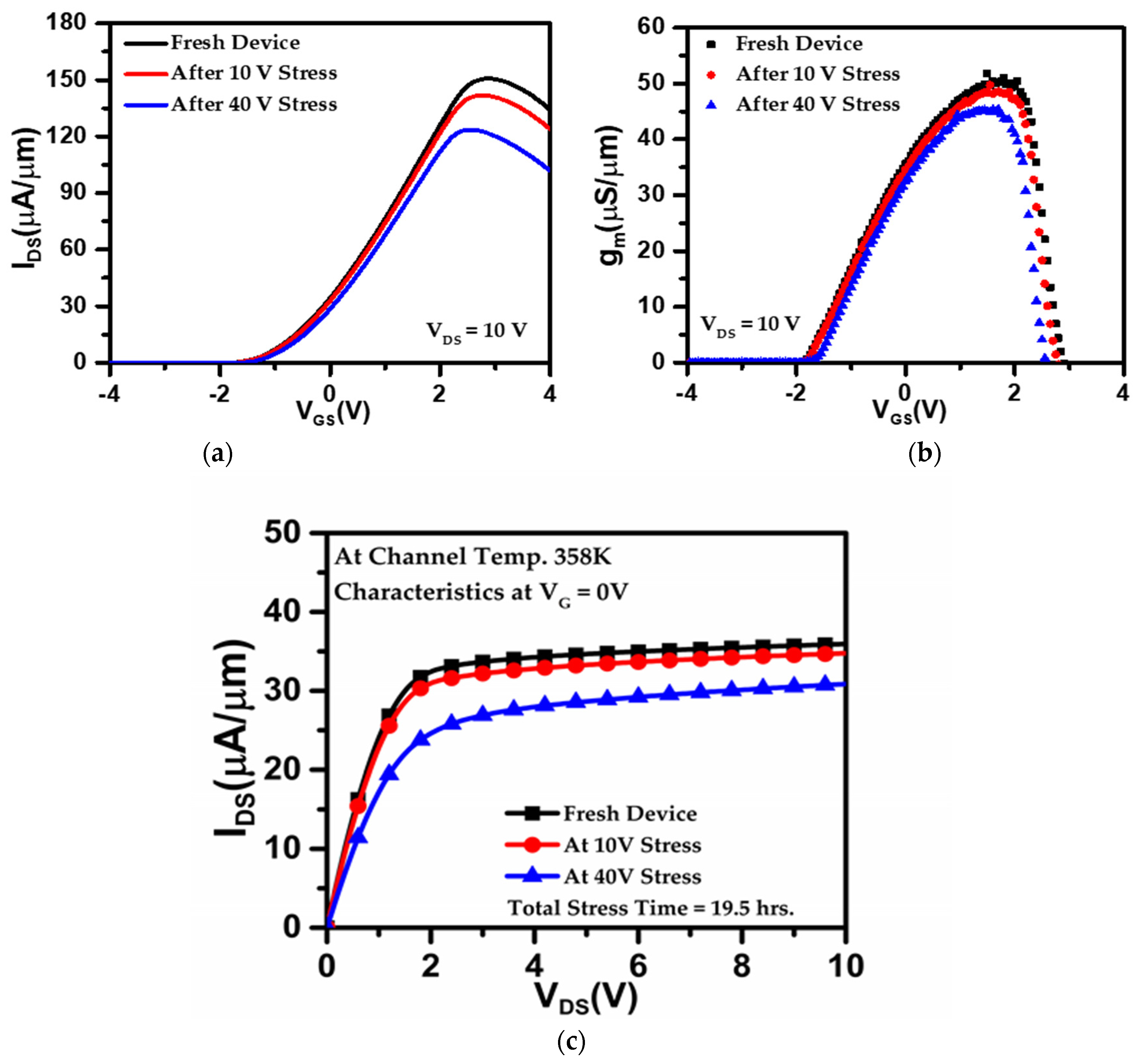
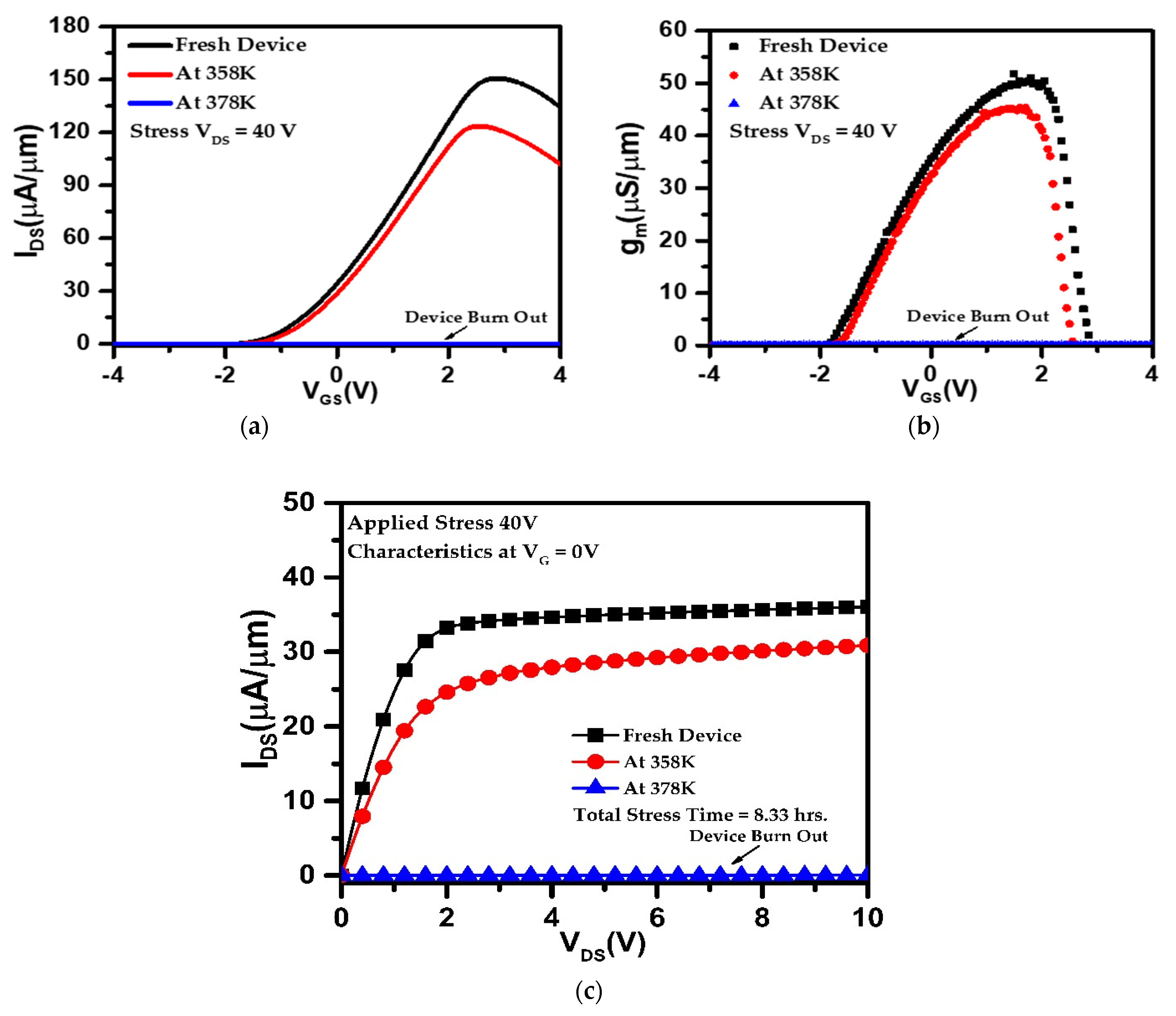
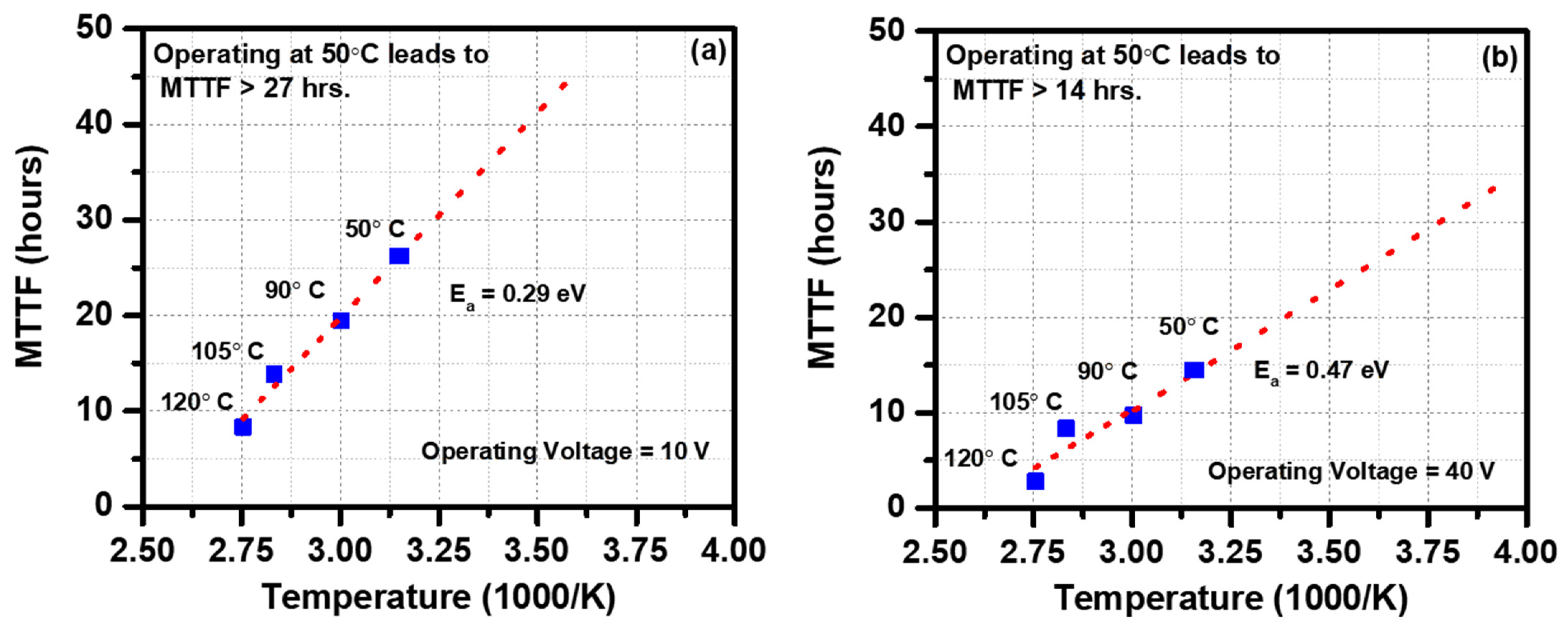

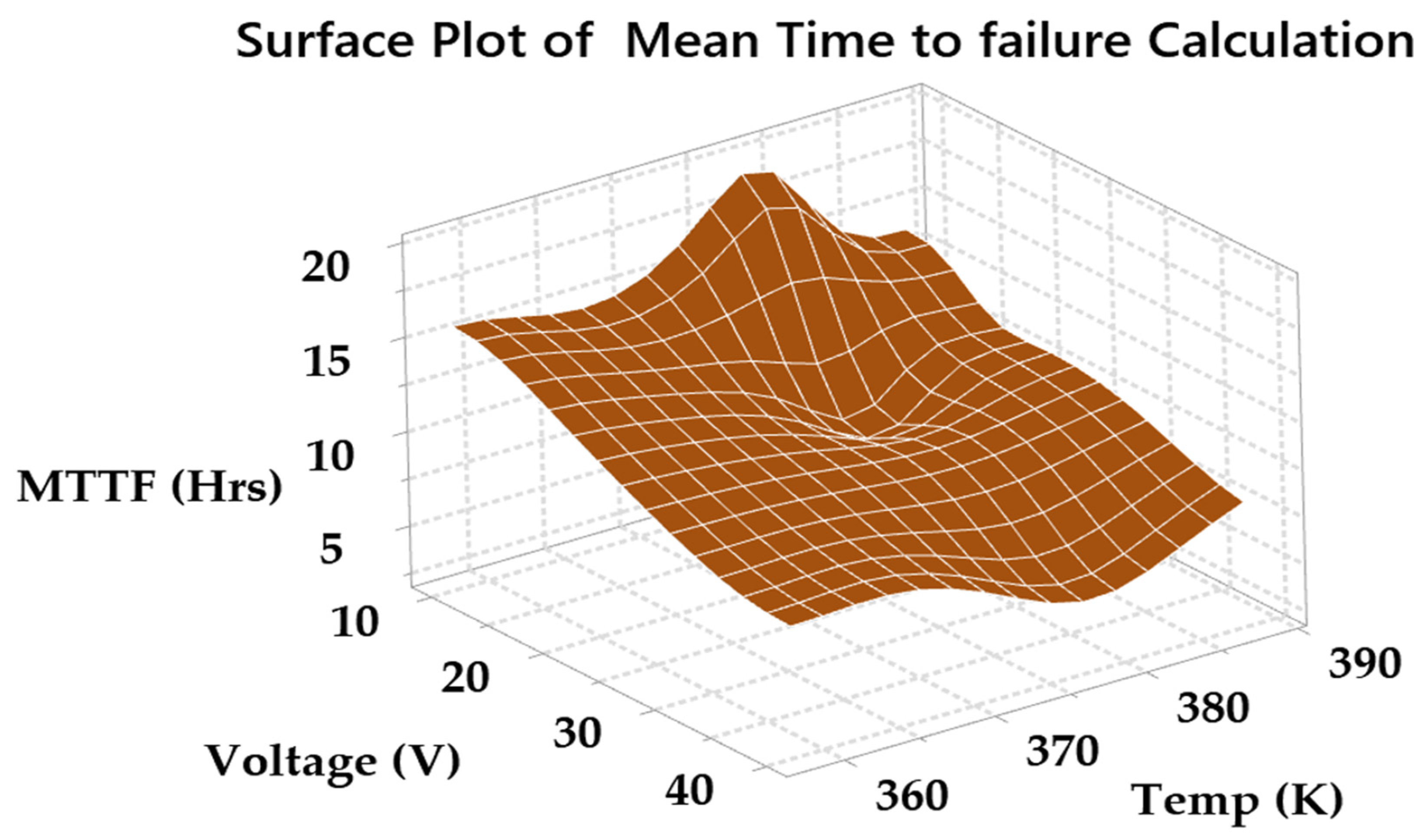
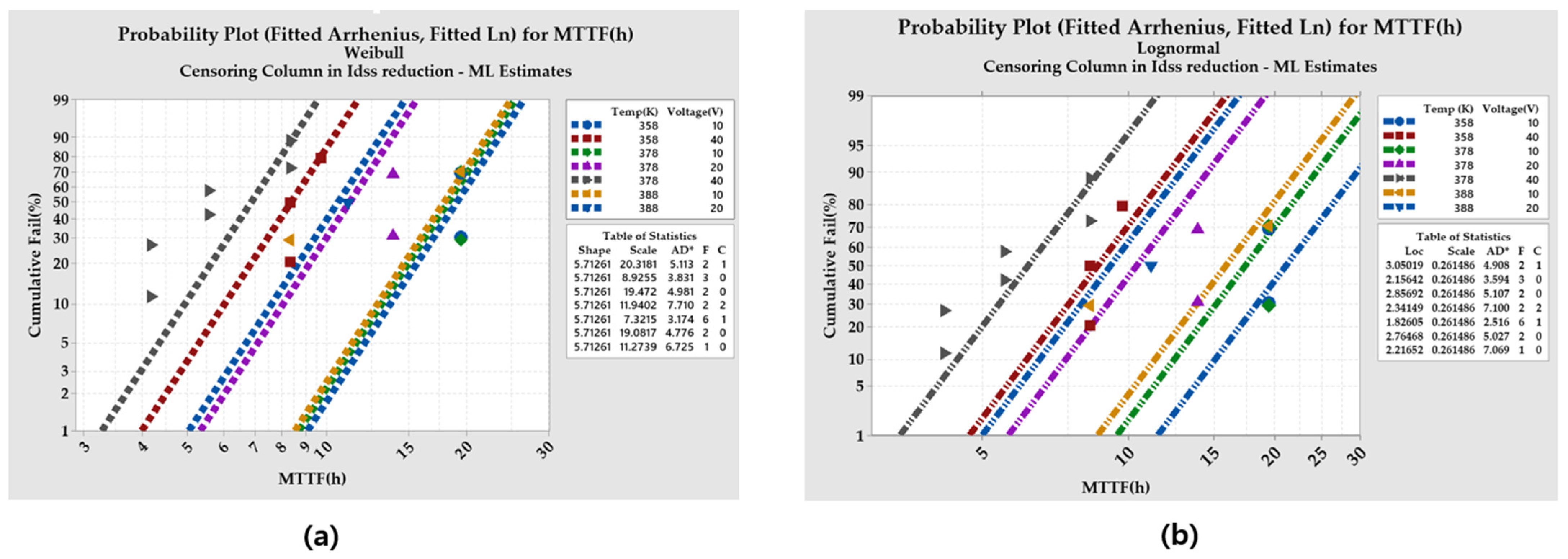
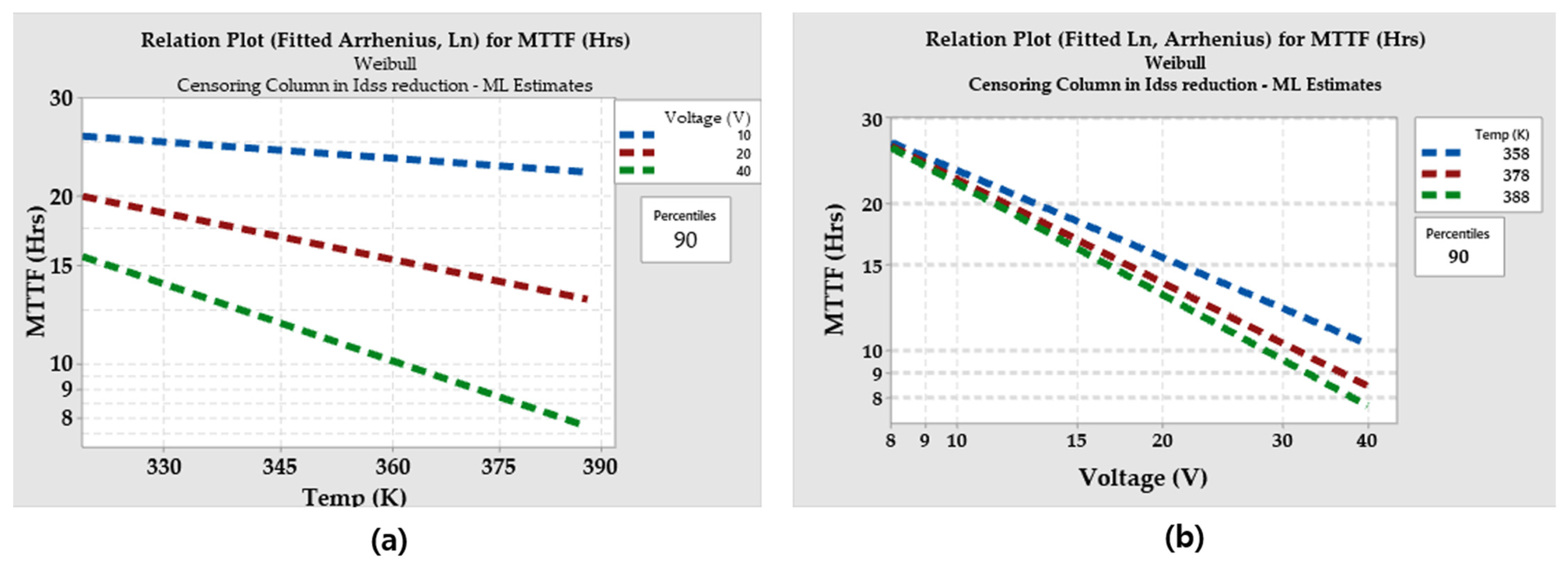
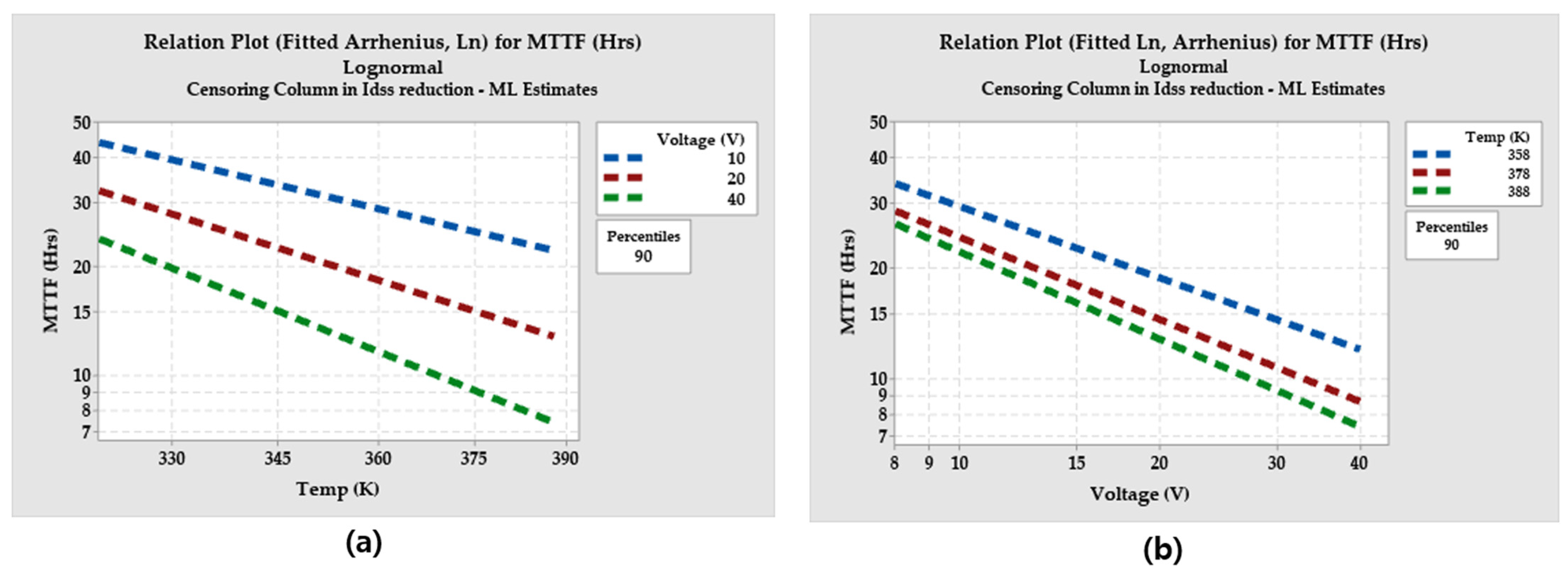

| Parameters | Voltage = 10 V | Voltage = 40 V |
|---|---|---|
| Saturation current (Idss (μA/μm)) | 3.36% | 14% |
| Transconductance (gm (μS/μm)) | 5% | 10% |
| On resistance (Ron (Ω/μm)) | 5.6% | 46% |
| Temperature (K) | Voltage (V) | MTTF (h) | Idss Reduction (%) Censor |
|---|---|---|---|
| 358 | 10 | 8.30 | 0 |
| 10 | 19.40 | 1 | |
| 10 | 19.40 | 1 | |
| 20 | 14.23 | 1 | |
| 20 | 9.10 | 0 | |
| 20 | 11.53 | 1 | |
| 40 | 8.30 | 1 | |
| 40 | 9.72 | 1 | |
| 40 | 8.30 | 1 | |
| 378 | 10 | 19.40 | 1 |
| 10 | 19.44 | 1 | |
| 20 | 2.77 | 0 | |
| 20 | 13.89 | 1 | |
| 20 | 2.77 | 0 | |
| 20 | 13.88 | 1 | |
| 40 | 4.17 | 1 | |
| 40 | 5.56 | 0 | |
| 40 | 2.77 | 0 | |
| 40 | 8.31 | 1 | |
| 40 | 8.30 | 1 | |
| 388 | 10 | 19.40 | 1 |
| 10 | 8.33 | 1 | |
| 20 | 11.11 | 1 | |
| 40 | Device damaged | N/A |
Publisher’s Note: MDPI stays neutral with regard to jurisdictional claims in published maps and institutional affiliations. |
© 2021 by the authors. Licensee MDPI, Basel, Switzerland. This article is an open access article distributed under the terms and conditions of the Creative Commons Attribution (CC BY) license (https://creativecommons.org/licenses/by/4.0/).
Share and Cite
Chakraborty, S.; Kim, T.-W. Investigation of Mean-Time-to-Failure Measurements from AlGaN/GaN High-Electron-Mobility Transistors Using Eyring Model. Electronics 2021, 10, 3052. https://doi.org/10.3390/electronics10243052
Chakraborty S, Kim T-W. Investigation of Mean-Time-to-Failure Measurements from AlGaN/GaN High-Electron-Mobility Transistors Using Eyring Model. Electronics. 2021; 10(24):3052. https://doi.org/10.3390/electronics10243052
Chicago/Turabian StyleChakraborty, Surajit, and Tae-Woo Kim. 2021. "Investigation of Mean-Time-to-Failure Measurements from AlGaN/GaN High-Electron-Mobility Transistors Using Eyring Model" Electronics 10, no. 24: 3052. https://doi.org/10.3390/electronics10243052






